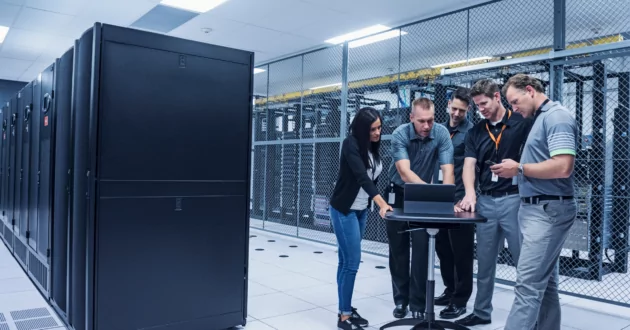<!—->
<!– –>

Some of the first teachings about improving the planet seem simple: reduce, reuse, recycle. People have since made lifestyle choices and adjustments, such as biking to work and segregating garbage, to bring this rule to life and help save the environment. Now, climate change is affecting businesses as much as individuals. According to the United Nations Environment Programme (UNEP), both consumers and investors are being turned-off by companies that ignore their environmental impact. Sustainable business practices are an essential part of an organization’s commitment to social and environmental responsibility. Sustainability in business also provides organizations an opportunity to create more efficient supply chains that have a positive impact on the planet.
Read our guide for sustainability leaders
Business activities that contribute to carbon emissions and fossil fuels also forced organizations and policymakers to hold leaders accountable for their actions against environmental impact. Likewise, employees and customers want to work for a company that is actively trying to reverse climate change and take part in environmental protection. There are various examples of sustainable business practices that companies can adopt to improve their business model. One common corporate sustainability strategy is known as the triple bottom line.
Sustainability trifecta: Triple bottom line
Profit, people and the planet comprise the trifecta that is known as the triple bottom line. A play on the business term “the bottom line,” otherwise referred to as profit, the triple bottom line adds two more players to the mix of modern-day business strategy. Sustainability is at the core of the triple bottom line, suggesting that companies that adopt sustainable business practices can protect the planet, serve the consumer and ultimately increase revenue.
Recycling programs, renewable energy sources, waste reduction and energy efficiency—all these things in theory can contribute to better environmental footprint. But what are some green business practices that organizations can implement today to achieve their sustainability goals?
Improving efficiency of energy management
Organizations can start to build their sustainability efforts through adopting more efficient energy sources. Alternative or clean energy does not harm the environment compared with fossil fuels and can often be used in place the latter.
Moreover, using the earth’s natural resources like sunlight, wind, water and others can create renewable energy. Generating power through natural processes help minimize carbon footprint. Google, for example, takes first place in purchasing the most renewable energy of any company over the past 10 years. The tech giant has matched 100% of electricity consumption with purchases of renewable energy. Sustainable businesses keep track of these metrics to be more proactive with their sustainability efforts.
Through carbon accounting, businesses can determine which activities are contributing to their production of greenhouse gas emissions (GHG). Implementing carbon accounting into a sustainability strategy proves to stakeholders that an organization is working on decarbonization due to environmental, social and governance (ESG) pressure to reach net zero.
Deploying new infrastructure
Decarbonization can be deployed through activities such as electrifying energy, targeting zero waste production and limiting business travel. Organizations can invest in renewable energy to help combat their carbon footprint. General Electric (GE) has committed to reducing their carbon footprint notably through renewable energy sources. The company offers various off and onshore wind, hydro power, hybrid, grid and service solutions.
Large enterprises are not the only contributors to decarbonization and protecting the environment. On the first episode of the Impact-Up podcast, we interviewed the California startup BAE Boats, which offers electric boating vehicles for short-term hire. Their electric boats provide customers with a more desirable experience over a traditional combustion engine as there is no noise or gas smell. With sustainability at the core of their brand but also their business value, BAE Boats has been able to grow their operations through the pandemic and beyond.
Developing dynamic supply chains
Sustainable supply chains are a foundational way for organizations to remain efficient while implementing sustainability means. Organizations with transparent supply chains show a commitment to social responsibility. Some examples of supply chain sustainability include recycling programs for packaging, exercising fair labor practices and responsibly sourcing materials from the local community.
Patagonia uses eco-friendly materials when creating their products and packaging. The company even reduces waste through recycling returns and other sustainable materials during the manufacturing phase. Patagonia also seeks to communicate their sustainability goals by educating consumers about the responsible consumption of clothing. The company promotes the “buy less, demand more” motto throughout their business model.
Resilient sustainability strategies
Many sustainability initiatives come from policy and will continue to rise as future generations grow increasingly supportive of environmental sustainability. Resilient businesses will adhere to external regulations on sustainable business practices (e.g., ESG regulations) while simultaneously committing to social responsibility. Companies with successful sustainability programs support both human rights and the environment. To implement resilient sustainable business practices, consider some of these other examples:
Employee well-being
Employees are the foundation of a successful organization, and their well-being is crucial to achieving sustainability goals. Businesses can adopt sustainability to create a healthier work environment. Microsoft is doing this through using renewable energy in their facilities. They also encourage employees to practice mindfulness, collaborate with the community, provide work-life flexibility, promote green space accessibility in the workplace and recognize employee achievements.
Fair trade practices
Raw materials are crucial to supply and supporting local communities allows for businesses to keep running at a foundational level. Economic stability is just as important as environmental impact for farmers. Companies who fairly compensate their local farmers through market wages and ethical work conditions are representing sustainable development. Starbucks is known for practicing fair trade practices with their local farmers.
Waste reduction
Eliminating plastics from our oceans and landfills is a common effort to protect the earth. Unilever is one of the fastest moving consumer goods companies and is also renowned for its goal to create a waste-free world. Unilever is not only cutting their plastic usage, but also fighting against food waste in their manufacturing.
Sustainability in business and IBM
Sustainable companies start from within. They begin with their local communities and ecosystems through making small changes. However, when larger companies start to exercise sustainability efforts, there is a ripple effect that impacts their stakeholders, employees and consumers.
IBM® believes that sustainable enterprises need to be responsible, equitable and viable to advance the quadruple bottom line. With deep industry expertise, ecosystem partnerships and proven methods, our sustainability consulting advisory services guide clients on best practices and the competitive advantage of their journey to become a sustainable enterprise.
Our end-to-end sustainability consulting capabilities embed sustainability solutions into an organization’s operations and culture. They span business strategy, ESG data, risk management and reporting, circular supply chains, reduced carbon emissions and the energy transition to renewable energy, intelligent assets, responsible computing and green IT.
Learn more about IBM Consulting sustainability services
Subscribe to the Impact-Up podcast
More from Business transformation

December 15, 2023
Customer service trends winning organizations need to follow
4 min read – Paying attention to the latest customer service trends ensures that an organization is prepared to meet changing customer expectations. Customer loyalty is waning, spurred on by the COVID-19 pandemic, social influences and the ease of switching brands. More than ever, organizations must stay on top of changes in the customer service experience to improve customer satisfaction and meet increased customer needs. A 2023 Gartner study found that 58% of leaders identified business growth as one of their most important goals.…

December 13, 2023
How to build a successful procurement strategy
5 min read – The role of procurement extends beyond transactional activities. A procurement strategy allows an organization to navigate an increasingly complex global supply chain, adapt swiftly to market fluctuations, and achieve cost optimization, operational efficiency and growth. By assessing and proactively managing risks inherent in the supply chain, organizations can shield themselves from disruptions and strengthen the resilience of their operations. In addition, a well-crafted procurement framework fosters innovation and sustainability. It can nurture collaborative partnerships with suppliers and integrate ethical and…

December 13, 2023
Seven customer service types that organizations should provide
4 min read – Conducting the best customer service strategy today requires organizations to invest in several customer service types. This way, organizations can ensure their customer base receives answers to their problems in the format they prefer. Customer service is an integral part of the customer experience. It has increasingly become an omnichannel discipline where every customer prefers to communicate on varying channels. Therefore, meeting customer needs requires an organization to enable different ways customers can receive responses to their issues depending on…

December 8, 2023
How to build a successful risk mitigation strategy
4 min read – As Benjamin Franklin once said, “If you fail to plan, you are planning to fail.” This same sentiment can be true when it comes to a successful risk mitigation plan. The only way for effective risk reduction is for an organization to use a step-by-step risk mitigation strategy to sort and manage risk, ensuring the organization has a business continuity plan in place for unexpected events. Building a strong risk mitigation strategy can set up an organization to have a…
IBM Newsletters
Get our newsletters and topic updates that deliver the latest thought leadership and insights on emerging trends.
Subscribe now
More newsletters
- SEO Powered Content & PR Distribution. Get Amplified Today.
- PlatoData.Network Vertical Generative Ai. Empower Yourself. Access Here.
- PlatoAiStream. Web3 Intelligence. Knowledge Amplified. Access Here.
- PlatoESG. Carbon, CleanTech, Energy, Environment, Solar, Waste Management. Access Here.
- PlatoHealth. Biotech and Clinical Trials Intelligence. Access Here.
- Source: https://www.ibm.com/blog/sustainability-in-business-examples/



